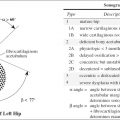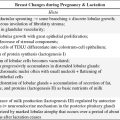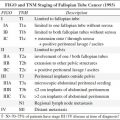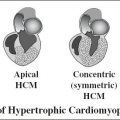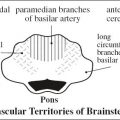
LIVER
Functional Segmental Liver Anatomy
based on distribution of 3 major hepatic veins:
(a) middle hepatic vein
divides liver into right and left lobe;
also separated by main portal vein scissura
(Rex-Cantlie line = extrapolated line from posthepatic IVC to long axis of gallbladder demarcating on liver surface anteriorly the right and left parts of liver)
(b) left hepatic vein
divides left lobe into medial + lateral sectors
(c) right hepatic vein
divides right lobe into anterior + posterior sectors
Each of the four sections is further divided:
by an imaginary transverse line drawn through the right + left portal vein into anterior + posterior segments; the segments are numbered counterclockwise from IVC
Portal Vein Anatomy (Akgul Classification)
Type A Normal anatomy: bifurcation of MPV and RPV (79–86%)
◊ Posterior branch of RPV as 1st portal vein branch (13%) = most common variant
N.B.: unintended devascularization of hepatic segments V + VIII during left trisegment-ectomy (resection of segments II, III, IV) / harvest of left lobe for liver transplantation if unrecognized
Type B Trifurcation of MPV (9–15%)
Type C Right anterior portal vein from LPV (1–4%)
Type D LPV from right anterior portal vein (0.3–1.2%)
Type E Right anterior portal vein from MPV (1–3%)
Maximum Cross-sectional Diameter of Portal Vein
(a) child < 10 years of age: 8.5 mm
(b) 10–20 years of age: 10.0 mm
(c) adult: 13.0 mm
Embryology of Portal Vein
Time: 4th–12th week of GA
› paired vitelline veins around duodenum → form 3 major side-to-side anastomoses (cranioventral + caudoventral + dorsal) → pierce septum transversum (primitive liver) → broken up into sinusoids → drain into sinus venosus (of primitive heart)
› selective involution of caudal part of right vitelline vein + cranial part of left vitelline vein:
» regression of caudoventral anastomosis
» dorsal anastomosis → main portal vein
» cranioventral anastomosis → left portal vein
» caudal right vitelline vein → superior mesenteric vein
» caudal left vitelline vein → splenic vein
Major Anatomic Variants of Portal Vein (rare)
1. Duplication of portal vein
2. Congenital portosystemic shunt
3. Congenital absence of portal vein
4. Absent branching of portal vein
5. Preduodenal portal vein
Hepatic Artery Anatomy (Michels classification)
Type 1 (55–60%):
› celiac trunk trifurcates into common hepatic artery (CHA) + left gastric artery (LGA) + splenic artery (SpA)
› CHA divides into
Location: CHA courses to right along superior ridge of pancreas branching at lower end of epiploic foramen
(a) proper hepatic artery (PHA)
Location: PHA courses right + upward along anterior border of epiploic foramen
(b) gastroduodenal artery (GDA)
› right hepatic artery (RHA) + left hepatic artery (LHA) arise from PHA
› middle hepatic a. (supplying caudate lobe) arises from:
(a) LHA / RHA
(b) PHA (in 10%)
Type 2 (4–10%):
› CHA divides into RHA + GDA
› LHA replaced to LGA
› middle hepatic artery from RHA
Type 3 (8–11%):
› CHA divides into GDA + LHA
› RHA replaced to SMA
› middle hepatic artery from LHA
Type 4 (2–4%):
› CHA divides into middle hepatic artery + GDA
› RHA + LHA are both replaced
Type 5 (9–16%):
› accessory L hepatic a. arises from LGA
Type 6 (1–7%):
› accessory R hepatic artery arises from SMA
Type 7 (1%):
› accessory R + L hepatic arteries
Type 8 (2–3%):
› combinations of accessory + replaced hepatic arteries
Type 9 (1–3%):
› hepatic trunk replaced to SMA
Type 10 (0.5%):
› hepatic trunk replaced to LGA
The presence of a portal branch without corresponding artery indicates a replaced or accessory vascular anatomy or transhepatic hepatofugal collateral vessels.
Aberrant Hepatic Artery
= hepatic artery coursing between IVC + portal vein
1. Replaced right hepatic artery (50%)
2. Right hepatic artery with early bifurcation of common hepatic artery into right + left hepatic arteries (20%)
3. Accessory right hepatic artery (15%)
4. Replacement of entire hepatic trunk to SMA (15%)
Left Hepatic Artery
= usually arises from proper hepatic artery (PHA)
Location: from hepatic hilum to umbilical portion of left portal vein (usually to its right) coursing up- and leftward
Accessory LHAs: from LGA / celiac trunk / aorta
Division (arteriographic description):
after forming an arch overriding the portal vein
› A2 branches: course to left corner of liver, usually superior to A3
› A3 branches: course ventral + caudal along left side of umbilical portion of PV and then toward left
Right Hepatic Artery
= usually arises from PHA / SMA when replaced
Accessory RHAs: from SMA / celiac trunk / aorta
Division (arteriographic description):
› anterior branch: straight right + upward course
› posterior branch: proximally meandering course
A6: inferolateral course to lower corner of liver
A7: compact complex meandering course superiorly (on frontal projection)
The RHA forms anterior and posterior branches characterized by a straight right upward course and by a meandering proximal portion, respectively.
Caudate Lobe
= located behind liver hilum + wrapping around IVC, supplied by multiple small branches from LHA + RHA
Variations (arteriographic description):
› RHA + LHA (53%)
› RHA only (35%)
Location: courses posteromedially mainly supplying the lateral (= paracaval portion and papillary process) of S1
› LHA only (12%)
Location: courses posteriorly mainly supplying medial portion (= caudate process, Spiegel lobe) of S1
Hepatic Vein Drainage Pattern of Right Hepatic Lobe (Nakamura Classification)
Type 1 Large right hepatic vein (RHV) drains extensive area of right lateral sector + part of right paramedian sector; small short hepatic vein drains small area of right lateral sector (occasionally absent) (39–57%)
Type 2 Right hepatic vein of medium size; one thick short hepatic vein of 5–10 mm in diameter (= middle / inferior hepatic vein) drains right lateral sector concomitantly directly into IVC (29–37%)
Type 3 Right lobe drainage allocated to a short RHV that drains superior part of right lateral sector and large middle hepatic vein (MHV) + inferior right hepatic vein that drains inferior part of right lateral sector (15–24%)
It is important to identify any variation in the middle hepatic vein because the hepatectomy plane in living donors is about 1 cm to the right of the middle hepatic vein along the gallbladder fossa.
Third Inflow to Liver
= aberrant veins supplying small areas of liver tissue + communicating with intrahepatic portal vein branches
Effect: focal decrease of portal vein perfusion resulting in areas of fat-sparing / fat accumulation
1. Cholecystic veins
› directly entering liver segments 4 + 5
› veins joining the parabiliary veins via triangle of Calot
2. Parabiliary venous system
= venous network within hepatoduodenal ligament anterior to main portal vein
Tributaries:
› cholecystic vein through triangle of Calot
[Jean-François Calot (1861–1944), French surgeon]
› pancreaticoduodenal vein
› right gastric / pyloric vein
√ pseudolesion at dorsal aspect of segment 4
3. Epigastric-paraumbilical venous system
= small veins around falciform ligament draining anterior part of abdominal wall directly into liver
Subgroups:
(a) superior vein of Sappey
[Marie Philibert Constant Sappey (1810–1896), professor of anatomy and president of the Académie Nationale de Médecine, Paris, France]
› drains upper portion of falciform ligament + medial part of diaphragm
› enters peripheral left portal vein branches
› communicates with superior epigastric + internal thoracic veins
(b) inferior vein of Sappey
› drains lower portion of falciform ligament
› enters peripheral left portal vein branches
› communicates with branches of inferior epigastric vein around the umbilicus
(c) vein of Burow
› terminates in middle part of collapsed umbilical v.
› communicates with branches of inferior epigastric vein around the umbilicus
(d) intercalary veins
› interconnect vein of Burow + inferior vein of Sappey
Normal Hemodynamic Parameters of Liver
Portal vein velocity: > 11 (range, 16–40) cm/sec
Portal vein cross-section: 0.99 ± 0.28 cm2
Congestion index: 0.070 ± 0.09 cm•sec
(= cross-sectional area of portal vein divided by average velocity)
Hepatic artery resistive index: 0.60–0.64 ± 0.06
Hepatic Fissures
1. Fissure for ligamentum teres = umbilical fissure
= invagination of ligamentum teres = embryologic remnant of obliterated umbilical vein connecting placental venous blood with left portal vein
› located at dorsal free margin of falciform ligament
› runs into liver with visceral peritoneum
› divides left hepatic lobe into medial + lateral segments (divides subsegment 3 from 4)
2. Fissure for ligamentum venosum
= invagination of obliterated ductus venosus
= embryologic connection of left portal vein with left hepatic vein
› separates caudate lobe from left lobe of liver
› lesser omentum within fissure separates the greater sac anteriorly from lesser sac posteriorly
3. Fissure for gallbladder (GB)
= shallow peritoneal invagination containing the GB
› divides right from left lobe of liver
4. Transverse fissure
= invagination of hepatic pedicle into liver
› contains horizontal portion of left + right portal veins
5. Accessory fissures
(a) Right inferior accessory fissure = from gallbladder fossa / just inferior to it → to lateroinferior margin of liver
(b) Others (rare)

Size of Liver
A. YOUNG INFANT
right hepatic lobe should not extend > 1 cm below right costal margin
B. CHILD
right hepatic lobe should not extend below right costal margin
C. ADULT
(a) midclavicular line (vertical / craniocaudad axis):
| < 13 cm | = | normal |
| 13.0–15.5 cm | = | indeterminate (in 25%) |
| > 15.5 cm | = | hepatomegaly (87% accuracy) |
(b) preaortic line < 10 cm
(c) prerenal line < 14 cm
Liver Capsule
= 2 adherent layers:
(a) thick, fibrous inner layer = Glisson capsule
(b) outer serous layer derived from peritoneum excluding
› bare area near diaphragm
› porta hepatis
› gallbladder attachment
Liver Echogenicity & Attenuation
US: pancreatic > splenic ≥ hepatic > renal echogenicity
CT: 50–65 HU (precontrast)
CECT: early arterial phase (20 sec), late arterial phase (30–40 sec), portal venous phase (60–70 sec); maximal enhancement at 45–60 sec
Enzymatic Liver Tests
A. Alkaline phosphatase (AP)
Formation: bone, liver, intestine, placenta
High increase:
cholestasis with extrahepatic biliary obstruction (confirmed by rise in γGT), drugs, granulomatous disease (sarcoidosis), primary biliary cirrhosis, primary + secondary malignancy of liver
Mild increase: all forms of liver disease, heart failure
B. Gamma-glutamyl transpeptidase (γGT)
very sensitive in almost all forms of liver disease
Utility: confirms hepatic source of elevated AP, may indicate significant alcohol use
C. Transaminases
High increase: viral / toxin-induced acute hepatitis
(a) aspartate aminotransferase (AST; formerly serum glutamic oxaloacetic transaminase [SGOT])
Formation: liver, muscle, kidney, pancreas, RBCs
(b) alanine aminotransferase (ALT; formerly serum glutamic pyruvic transaminase [SGPT])
Formation: primarily in liver
• rather specific elevation in liver disease
D. Bilirubin
helps differentiate between various causes of jaundice
(a) unconjugated / indirect bilirubin = insoluble in water
Formation: breakdown of senescent RBCs
Metabolism: tightly bound to albumin in vessels, actively taken up by liver, cannot be excreted by kidneys
(b) conjugated / direct bilirubin = water-soluble
Formation: conjugation in liver cells
Metabolism: excretion into bile; NOT reabsorbed by intestinal mucosa; excreted in feces
Elevation:
› ↑ production: hemolytic anemia, resorption of hematoma, multiple transfusions
› ↓ hepatic uptake: drugs, sepsis
› ↓ conjugation: Gilbert syndrome, neonatal jaundice, hepatitis, cirrhosis, sepsis
› ↓ excretion into bile: hepatitis, cirrhosis, drug-induced cholestasis, sepsis, extrahepatic biliary obstruction
E. Lactic dehydrogenase (LDH)
nonspecific and therefore not helpful
high increase: primary or metastatic liver involvement
F. Alpha-fetoprotein (AFP)
> 400 ng/mL strongly suggests that a focal mass represents a hepatocellular carcinoma
PORTA HEPATIS
= LIVER HILUM
= deep short transverse fissure that passes across left posterior aspect of undersurface of right lobe of liver separating caudate lobe from quadrate lobe
Contents:
(a) portal triad:
1. Main portal vein (MPV)
2. Proper hepatic artery: left anterior to MPV
3. Common hepatic duct: right anterior to MPV
(b) nerves: left vagal trunk + sympathetic hepatic plexus
(c) lymphatics
Within the porta hepatis, the common bile duct and proper hepatic artery typically are located anterior to the portal vein, with the common bile duct to the right and the proper hepatic artery to the left.
Stay updated, free articles. Join our Telegram channel

Full access? Get Clinical Tree







